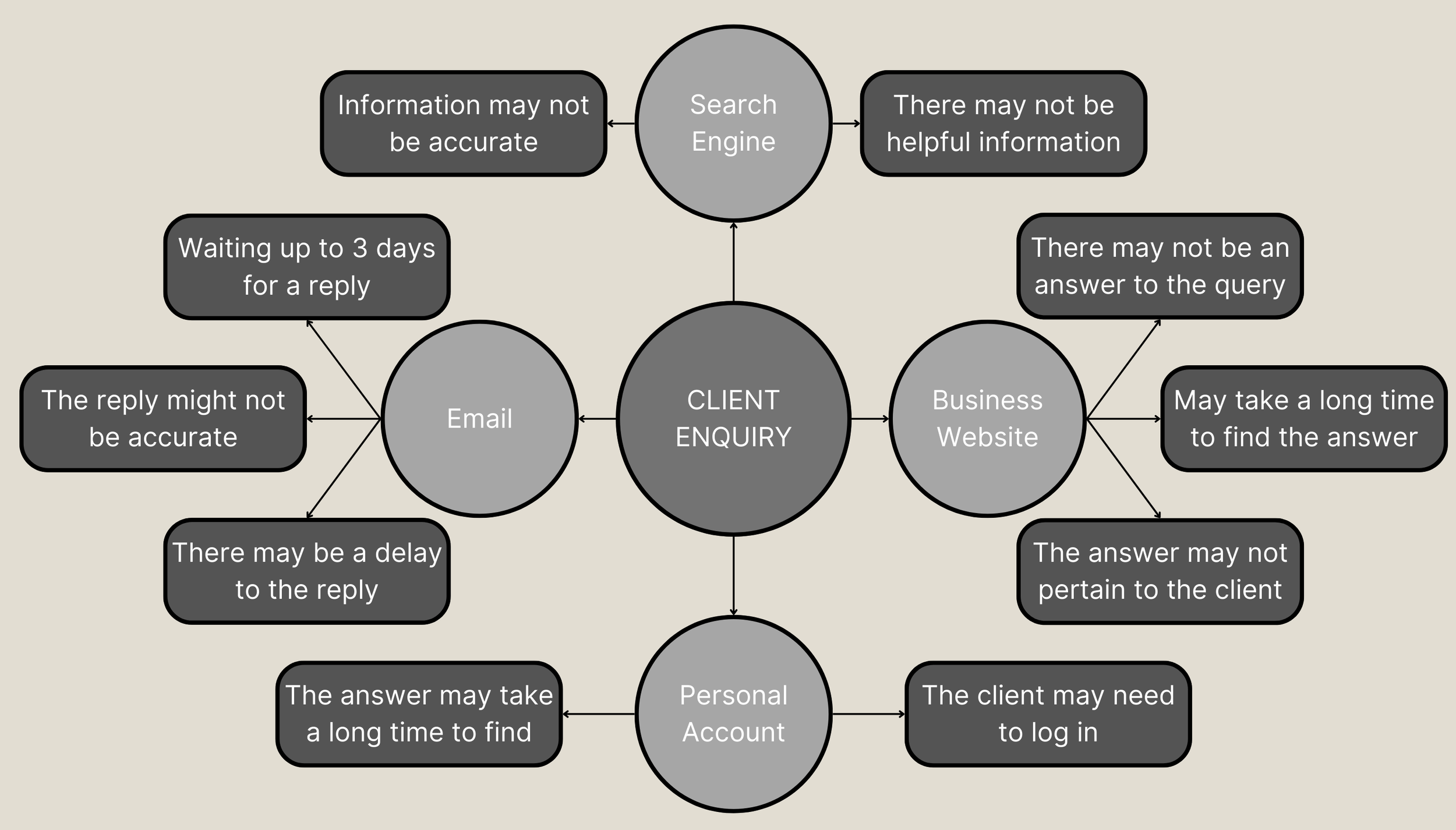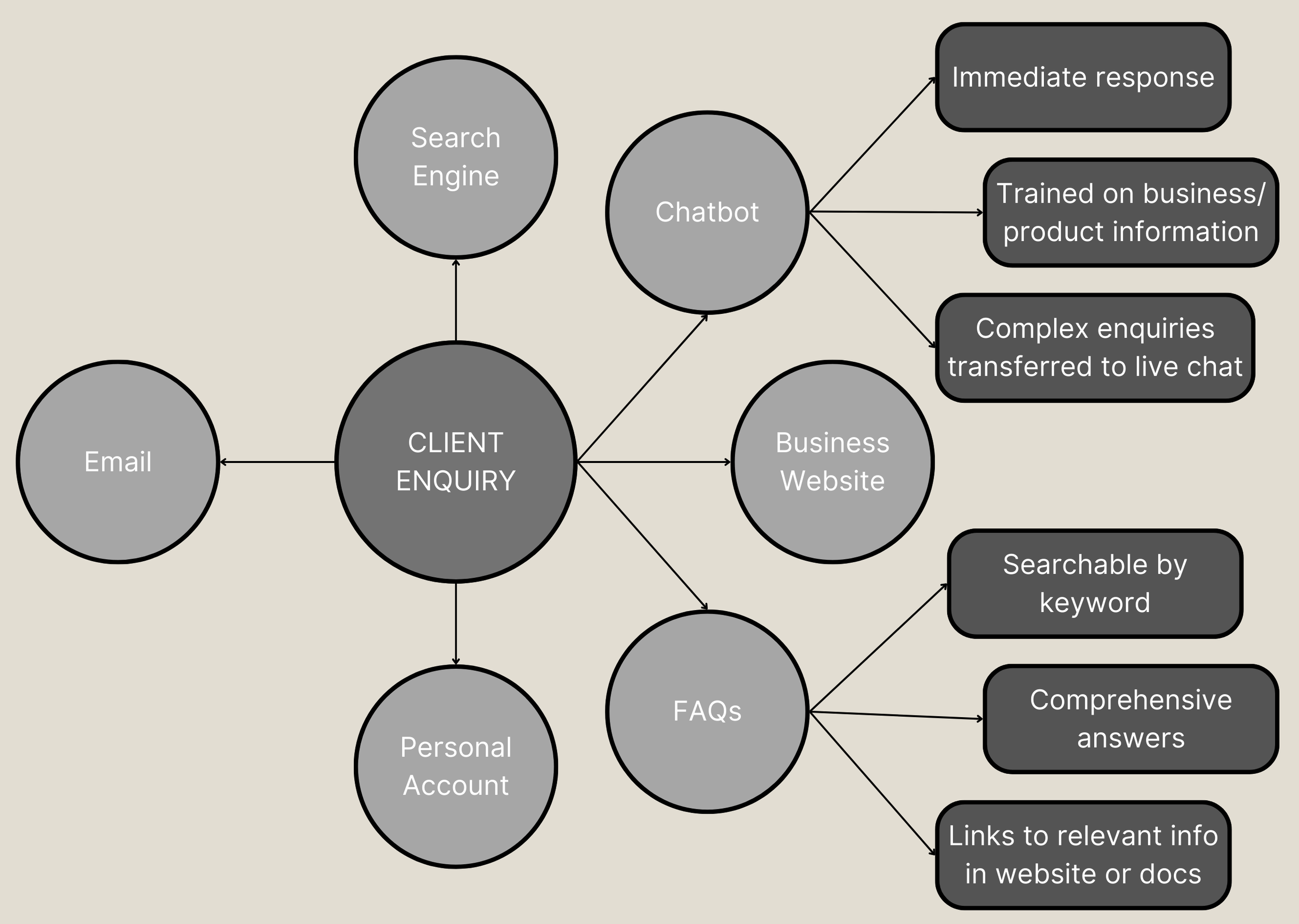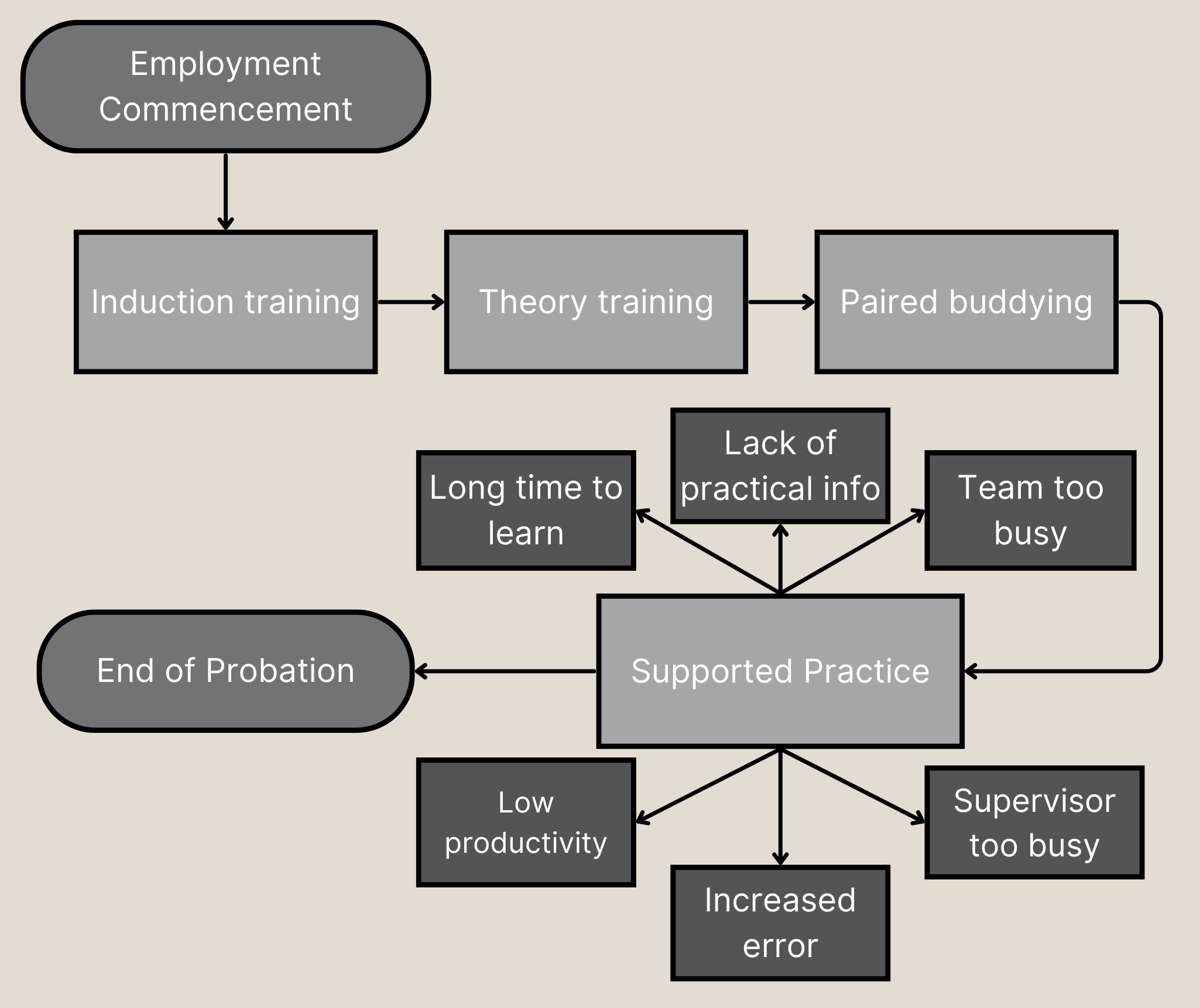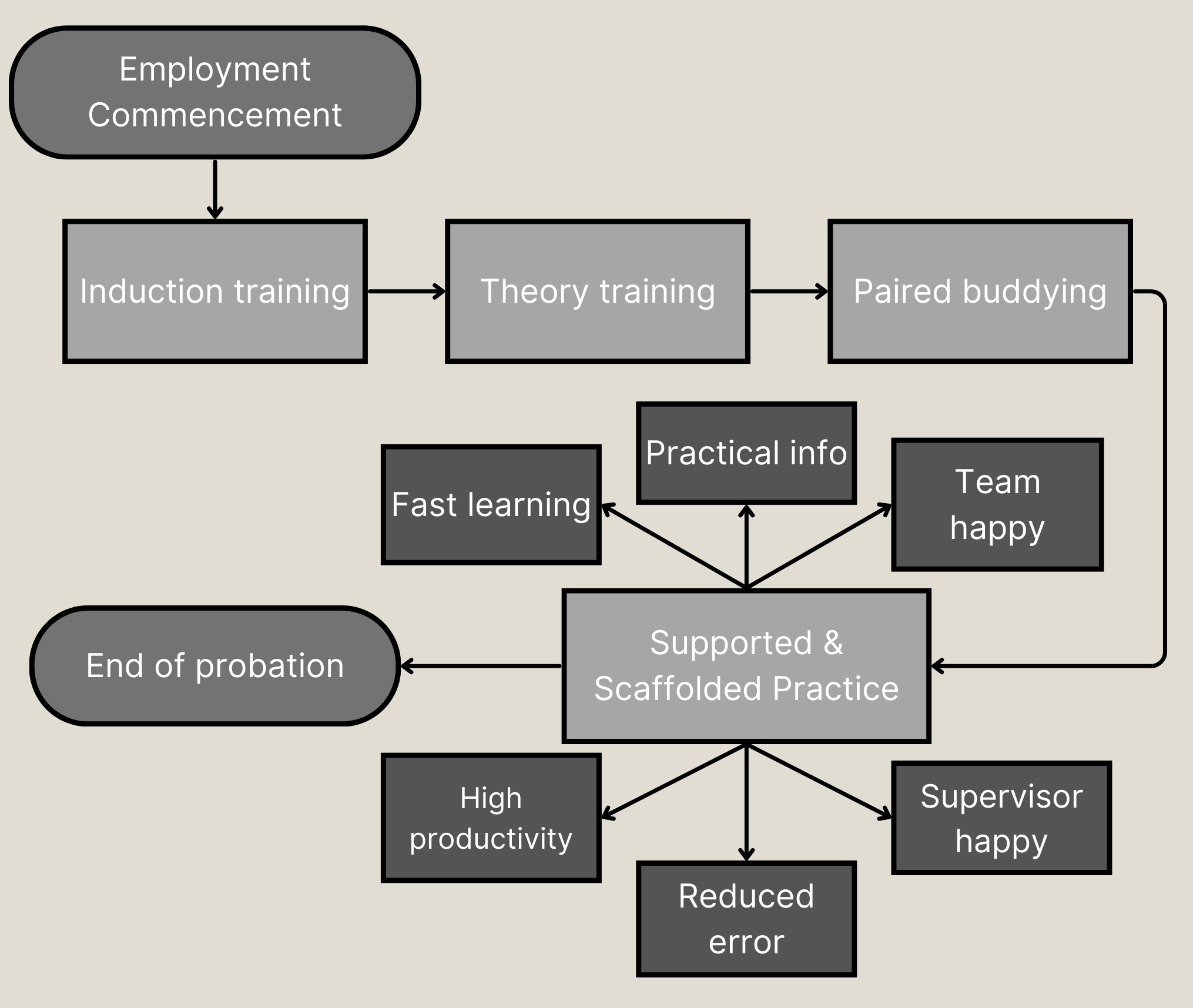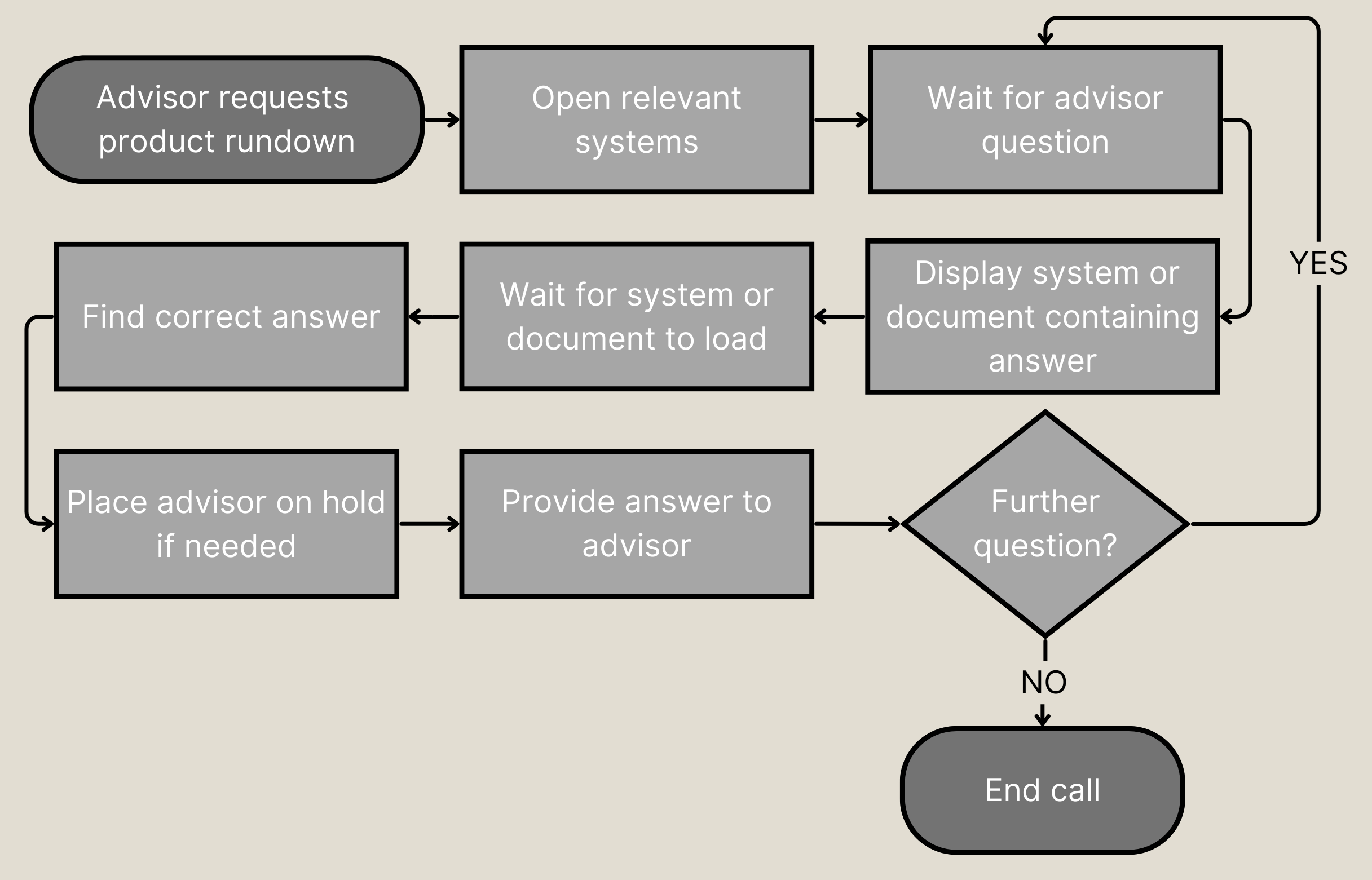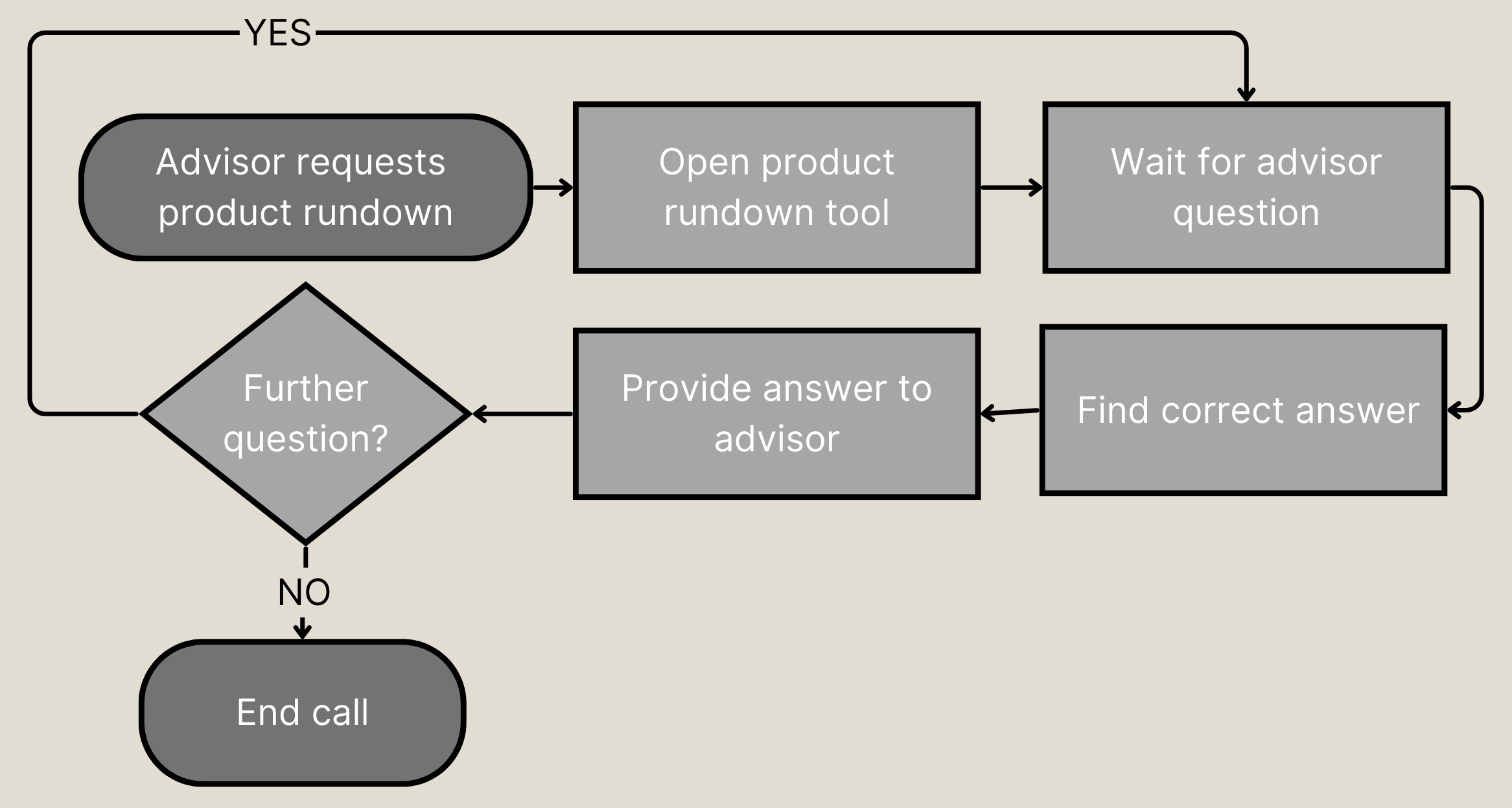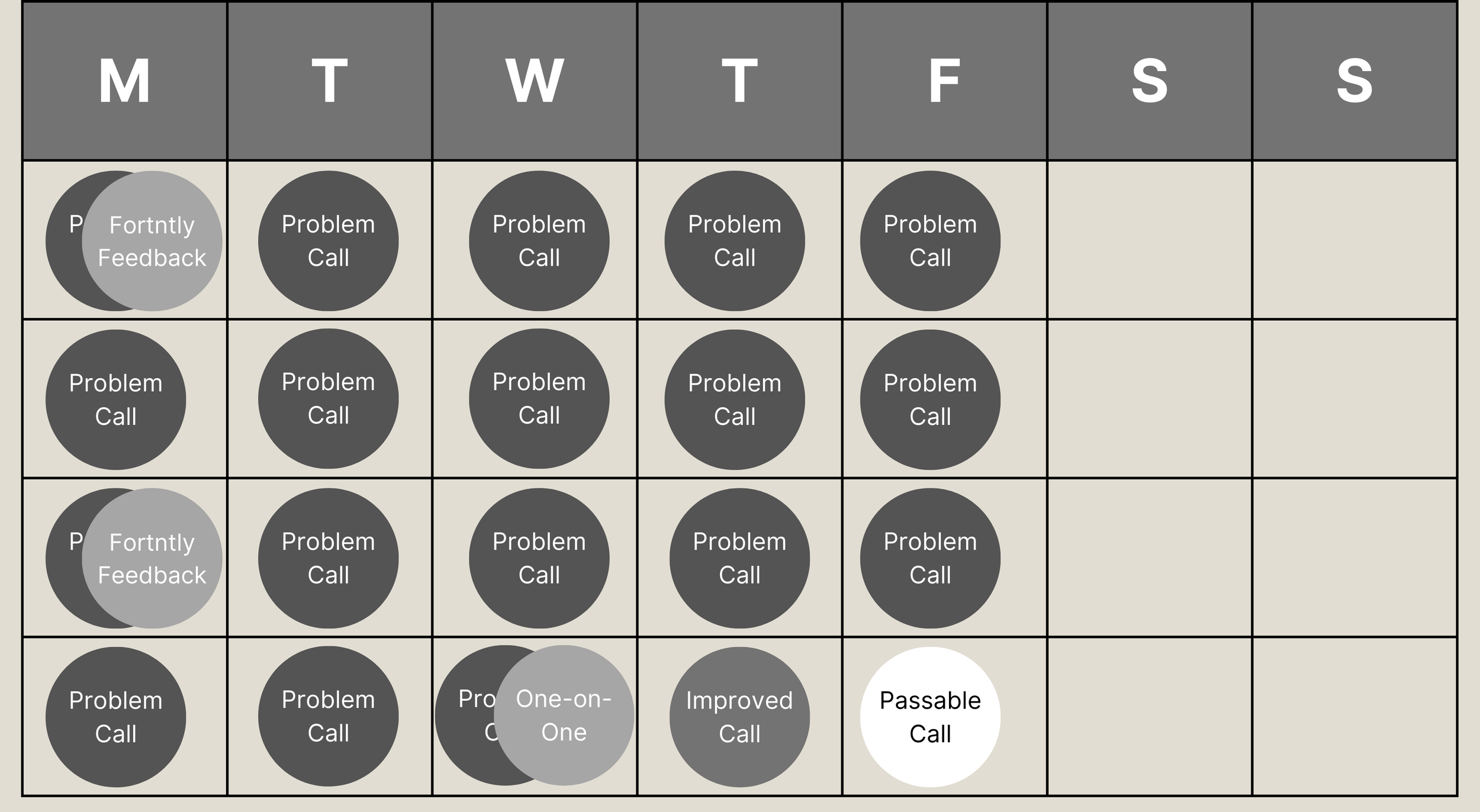
Overview
Organisation: Financial services provider
Structure: Corporation
Lifecycle stage: Shake-out
Goal: Service innovation
Solution: AI adoption plan and prototypes
Technology: Salesforce
Project duration: 6 months
This case study is a compilation of smaller projects undertaken at more than one company, here placed in the scenario of preparing an AI adoption plan and prototypes for quick wins at a financial services call centre. Each project aimed to digitalise processes while improving customer experience or CX and employee enablement and experience, or EX, which today could be advanced further with generative or other AI, machine learning, and advanced analytics capabilities of software such as Salesforce. Project modules included a client chatbot and FAQs, staff knowledgebase, insurance quote generator, financial advisor call tool and portal, and real-time staff performance management tool.
Analysis
83% of organisations agree that CX is a weak link in their product or service, and that this has a negative impact on their business.
Source: NTT Ltd, 2023.
Strategy
“AI, ML and bots are considered the #1 enabler that is key to reshaping CX and EX capabilities in the next three years”. NTT, 2023.
Nippon Telegraph and Telephone (NTT) has conducted its Global Customer Experience Benchmarking Report series for over 25 years in a range of industries, and in 2023 interviewed 1442 CX and EX decision-makers and influencers across a range of business roles within 14 sectors in 25 countries across five regions. The survey produced many convincing findings in the context of a call centre seeking to increase its CX and EX through service innovation with AI:
92% agree that CX improvements have impacted their business growth
91% agree that improvements in EX directly impact their profit
79% of organisations reported having a CX and EX strategy in place
This group also reported having promoter-level CX ratings more than five times higher than other organisations
Organisations with CX and EX strategies are almost six times more likely to achieve promoter-level CX performance in NPS
Best Practice: What do top performers do differently?
The survey identified a group of top performers, defined as achieving revenue growth of over 10% and operating profit over 15% of revenue over the past fiscal year. Factors contributing to their success include that they were:
Three times more likely to have significantly improved CSAT
91% more likely to have significantly increased employee satisfaction
25% more likely to offer top-rated CX via AI
27% more likely to be in an advanced state of digitalisation
Already prioritising AI and predictive analytics in the short-term
Recommendations
In regards to undertaking the groundwork for CX design, NTT (2023) describe three important factors as: online communities to gain insight into customer issues, employee intelligence - with 92% of organisations capturing voice of employee or VoE data to support employee engagement, and real-time customer feedback, said to be rated by organisations as the most important input for this effort. The five prototypes were based directly on the latter two, including observation, procedure walkthroughs, desktop review, listening, and interview, and could form the foundation for assessing enterprise software vendors to find the most appropriate solution. Here, the organisation already uses Salesforce and would just need to make use of its full capabilities as they are today, as outlined below.
AI Adoption Plan
Salesforce AI
Every year, Salesforce conducts studies into trends across professions, industries, and geographies, with the most recent report released in April 2024 (Salesforce, 2024) focusing on the broadscale adoption of artificial intelligence in areas like customer service, marketing, and sales, issues in its implementation such as customer trust, and the impact of its deployment on the workforce and organisational talent needs. In the opening letter, Salesforce AI CEO, Clara Shih, makes three important observations that are pertinent to this case study: first, that a key factor in successful enterprise AI implementation is focusing on the highest impact, turnkey use cases that address bottlenecks, pain points, and performance improvement opportunities, and offer the fastest, lowest-risk path to validation; second, that data is the spine of every AI strategy and core to unlocking its full potential, with much of this data already in the company’s CRM; and third, that we’re now entering the time when agentic AI with increased autonomy is going to become more common in the enterprise. Accordingly, the approach recommended in the following section and applied in the design and evaluation of prototypes below reflects this strategy.
Customer Experience
Automated Service
Salesforce Einstein Bots for businesses have been around since 2018 and can provide a multi-channel, multilingual conversational AI tool that integrates with the company’s Salesforce data. The bots can be used for both client-facing and internal use, and integrated into websites, apps, and other channels.
On 12 September 2024, Salesforce launched Agentforce, a suite of low-code, autonomous AI agents which aims to provide AI-augmentation for employees in areas like customer service, sales, and marketing, through tasks such as answering enquiries, qualifying sales leads, and optimising marketing.
Each of these tools could be used to design, create, test, deploy, and maintain a hybrid automated and live digital conversational channel for clients at the financial service to interact with the business at their convenience. Agentforce also has the capability to transfer an enquiry to a human with a summary and recommendations.
Self-Service
Salesforce AI capabilities also have potential to allow clients to obtain a product quote without having to speak with a human agent or input multiple variables into an interface that may seem complex and overwhelming, however simple its design. Instead, the customer can use natural language to phrase their question using chat.
Salesforce Agentforce, through Agentforce Atlas Reasoning Engine, can also analyse data, make decisions, and provide results autonomously, enabling proactive, hyper-personalised product recommendations, including for financial products a client may benefit from, such as insurance, that the client may not have previously considered.
Lastly, Salesforce Customer Portal can assist the business to create a portal for customers and stakeholders to access the specific company, product, service, client information and data that they need for their own purposes. For example, enabling financial advisors to use self-service, as described in the prototype below.
Employee Experience
Employee Enablement & Empowerment
Where enablement is about providing employees the support and resources they need to make informed decisions, empowerment is focused on giving employees authority to take action on those decisions. The Insurance Quote Generator and Financial Advisor Call Tool described below were designed towards the goal of the former, and the Real-Time Performance Management Tool towards the latter.
Where the role of the service-based tools could now be satisfied by the Salesforce Agentforce suite providing self-service for clients and financial advisors, empowering the employee with their own self-management resources such as real-time performance monitoring would still seem a challenge. However, the combined capabilities of Agentforce, Einstein, and Salesforce Contact Centre make it possible, uniting real-time data, predictive analytics, conversational interaction, hyper-personalisation, automation, and autonomous action in the contact centre setting.
Knowledge-Centred Service
Salesforce participates in the Consortium for Service Innovation, a non-profit alliance of organisations working towards innovation in customer and employee engagement. One initiative of the Consortium is Knowledge-Centred Service, which describes a way of interacting with knowledge that enables teams to answer questions quickly, deliver those answers where people are looking for them, and drive improvements into products and services (Consortium for Service Innovation, 2024).
An example of implementing Knowledge-Centred Service is through a knowledgebase for staff in a contact centre, as described later in this case study, enabling general enquiries to be answered and basic technical troubleshooting. Salesforce offers two ways to create a knowledgebase, Classic Knowledge and Lightning Knowledge, based on business requirements, with Lightning Knowledge able to access Einstein article recommendations based on past searches.
Quick Wins
Module 1: Client FAQs and Chatbot
Challenge
The financial service operated a small call centre, for which call levels fluctuated throughout the year, increasing in the lead-up to the new financial year in July, and whenever the government launched a new law or program in relation to personal finance, such as superannuation initiatives, and decreasing significantly towards the calendar New Year holiday period.
Alternatives available to clients of the service to have enquiries answered were search online through the business website, their personal account, or a search engine such as Google, or to email the business, for which the standard response time was within three business days. As a result, call queues could entail waiting times of up to half an hour to reach an operator.
With its existing service delivery system, the business needed to increase staffing resources to cope with the higher call volumes, with the associated financial cost. Where this involved hiring new employees, the training and on-the-job learning period would inherently entail lower productivity and increased errors in service delivery, compared to experienced staff.
Solution
An analysis was undertaken of approximately 200 calls received pre- and post- the end of the financial year to identify call characteristics and themes. This found three caller categories that comprised 87% of calls and 10 common enquiry topics, with approximately 15% of all enquiries of a nature that could be answered effectively using a website FAQs page or chatbot.
From this information, a set of 30 FAQs were created and set out with their answers on a web page prototype. The FAQs were then used to develop the framework of a chatbot prototype, by listing against each question 10 alternative phrases that may be used with the same intent, and then creating five follow-up questions that the user may ask upon receiving each answer.
Using a free trial of a simple consumer live chat/chatbot application, a generic prototype was created with the original 30 questions plus a sample of 20 from the extended question set. The chatbot prototype was then used in a test environment on the website of the chatbot provider to evaluate the performance of the key questions, alternative phrasing, variations on the alternative phrasing, and the extended questions.
Potential Benefits
Deployed and maintained successfully, the use of digital and AI technology to assist clients with general enquiries has the potential to save a business such as a financial service the costs of hiring additional workers to cover peak periods such as end-of-financial-year, whilst giving existing call centre staff more time and attention to answer complex account enquiries. Undoubtedly, clients would also be grateful to not have to wait through lengthy call queues to have their enquiries answered.
Chart calculation based on cost of three months’ full-time wages for one extra worker at $44.40 p/hr gross, superannuation incl., versus running a 4-hour Saturday shift to catch up on any admin for three months at time-and-a-half, per person.
Module 2: Staff Knowledgebase
Challenge
Inconsistent methods were used among team members to deal with client enquiries, resulting in client expectations not being met and ensuing complaints. Where staff were uncertain of the correct way to answer or handle an enquiry, the staff member would then need to check with a team member or the supervisor before proceeding. This would mean longer call times or repeated calls from clients trying to speak to the person they had originally been assisted by.
Staff training involved a one-week induction, then three weeks of theory learning with a trainer, before being buddied with a team member for three days to sit and hear them answer calls and observe them navigate the information systems to satisfy enquiries. From this time the staff member would commence their role with support available on request from team members and the supervisor, online resources such as the business website, and other publicly available information.
Solution
The FAQs and extended question set created in the first module were then used as the foundation for a knowledgebase for staff to reference when answering enquiries. The knowledgebase would provide details such as the question, alternative phrasing to enable easy search, the answer and how it is found - through which steps, systems, or websites, and what to do or who to refer it to in the most complex or irregular cases.
Potential Benefits
Chart calculation based on industry average FCR of 75%.
A knowledgebase to assist call centre staff in answering enquiries can increase client first-call resolution by up to 15% (Atlassian, 2024), receive a consistent service quality, and will be made aware of what to expect. Additionally, new staff will have an extra level of scaffolding to support them as they learn the role, enabling them to interact confidently and positively with clients, while team members can save the time they would have spent assisting them.
Module 3: Insurance Quote Generator
Challenge
Within the call centre, when clients called to request a quote for insurance, a manual process needed to be undertaken by the operator during the call, which entailed placing the caller on hold multiple times while two lengthy reference documents were downloaded, before running through a series of questions to the caller about their needs, checking various details on their account across several screens, and then performing a manual calculation to create the quote from the documents. The eagerness of the client to find out the information and perhaps purchase the insurance was somewhat tempered by the time they received the quote, resulting in client dissatisfaction and lost business for the insurance product. It was clear that this process did not meet the expectations of anyone partaking in it.
Solution
A prototype of a digital insurance quote generator was created using Excel, whereupon the information from the range of insurance products offered by the business was entered with formulas to calculate the unit price of each product based on variables to be entered in by the operator, as received from the caller, such as their age, occupation, and existing financial products. Extensive testing of the quote generator was then undertaken using hypothetical client examples, and modifications made to improve it, before putting it to use in the call centre in response to client insurance enquiries.
Results
Use of the insurance quote generator with client enquiries resulted in reducing the time taken to complete the process from 9.4 minutes to 4.6, excluding any waiting time the caller had experienced before reaching the operator. It was not possible to evaluate the effects on client insurance uptake, but each client was noticeably as interested and eager at the end of the call as they were at the start, only wanting to take the time to think about it, discuss it, or compare it to other products available. As well as being a useful tool for the call centre operators, such a resource could easily be integrated into the business website or client account portal for self-service.
Module 4: Financial Advisor Portal
Challenge
The analysis undertaken in Module 1 found that 12% of calls received by the financial service were from financial advisors on behalf of clients, to check basic product information and standard details of the client’s account. Though the wording that the advisors used to ask these questions or the sequence in which they asked them might vary slightly, the questions were generally read from a list, consistent across organisations. This enquiry was often referred to as a product rundown and the advisor would have little time for delays, preferring a quick and easy transactional process.
Solution
A prototype of a digital financial advisor portal was created in the form of an Excel tool with each question typically asked by the advisor in a fund rundown listed. Against the questions which referred to financial product information and did not require access to the client’s account, the answers for each product were provided, with the question row/column frozen to allow easy scrolling across to the details of the relevant product. Where questions referred to the client account, information was provided on where to find that answer and how to calculate it if necessary. This enabled the operator to anticipate the need to access different systems or records and open these at the start of the call when the advisor identified themselves, mitigating delays caused by issues such as slow software or internet connection. The tool was then tested against hypothetical financial advisor enquiries for clients with different products to ensure it was ready for use in live calls.
Results
Utilisation of the tool with enquiries from financial advisors representing different companies produced consistently positive results, reducing the average time to complete a product rundown for one operator from 12 minutes to 7 minutes. Such a tool that is tested so extensively in practice forms a robust foundation for a digital portal for financial advisors accessed via the business website, with a secure means of accessing information on their clients, based on the original authority given by the client to the financial service for the advisor to access information on their behalf.
Module 5: Automated Real-Time Performance Management
Challenge
The financial services call centre provided feedback to operators on a fortnightly and monthly basis, where the former was conducted by the supervisor listening to three random calls of the operator and providing brief coaching based on their assessment; and the latter delivered in the form of a one-on-one meeting based on the operator’s achievement towards call centre metrics over the period, which would often be the first occasion that any problem calls over the previous month that didn’t result in complaint would be identified for the operator. Hence the session often covered calls that the operator had by then forgotten about, had otherwise lost their impression on the operator, or which they had moved past by self-reflection and improvement. As a result, the feedback provided would less likely have the intended effect on the operator’s behaviour, and performance issues may linger.
Solution
A prototype performance monitor was created in Excel whereby the operator could see each metric for each call they had just completed, with a tally of their calls over that day, that week, and that month, showing them their progress. The performance monitor had a colour-coded columnar section for each day, week, or month, where the colour would reflect their overall performance during that time, and change with their performance during that period. For example, bright blue - a company branding colour - would signify high performance, green a good performance, yellow an alert to improve, orange a warning, and red an alarm for the operator. Based on the score for each metric, relevant tips and information could be automatically displayed.
Results
Based on a comparison between the performance of one operator using the tool over a two-month period and their previous performance and any improvement in it after receiving the regular supervisor feedback, use of the performance monitor resulted in an increase across all quantitative metrics, specifically, average talking time or ATT, after call work or ACW, and average handling time or AHT, where results improved over the two months by 8%, 17%, and 13%, respectively. The performance monitor was limited in not being able to measure or provide feedback on call quality measures such as tone, accuracy, and client satisfaction.
Summary & References
Through business analysis methods such as strategy analysis, elicitation, solution design and evaluation, and application of design thinking, undertaken at a corporate financial services call centre, this project identified five easy ways to improve customer and employee experience through advancing its digital capabilities and adopting AI with the existing Salesforce system. With substantial value found to be added with these improvements across client and stakeholder satisfaction, employee performance, and cost savings to be made in areas like labour and complaints handling, the greatest risk lies in delaying or failing to initiate the process.
REFERENCES
Atlassian (2024). ITSM for high-velocity teams. Viewed 14 September 2024.
IIBA (2015). Business Analysis Body of Knowledge.
NTT (2023). 2023 Global Customer Experience Report.
Salesforce (2024). Trends in AI for CRM.
Related Case Studies
Project Process Optimisation
Architecture Service Digitalisation

